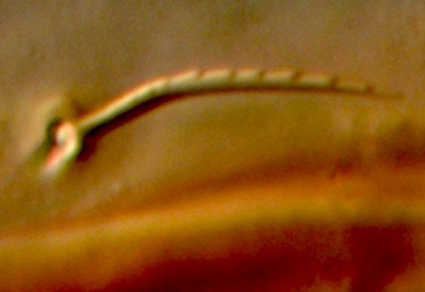Abstract
A new oribatid mite genus, Luisumaoppia gen. nov. (Oribatida, Oppiidae, Oppiinae), with Luisumaoppia molinoensis sp. nov. as type species, is described from soil and leaf litter in primary mountain cloud forest in Andes, Peru. It differs from the other genera of Oppiidae by the presence of modified (nearly straight), directed backwards leg claws located on bent pretarsi. The relationships of Luisumaoppia gen. nov. with the related genera in Oppiinae are presented.
References
Aoki, J. (1984) New and unrecorded oribatid mites from Kanagawa, central Japan (I). Bulletin, Institute of Environmental Science and Technology, Yokohama National University, 11, 107–118.
Balogh, J. (1970) New oribatids (Acari) from Ceylon. Opuscula Zoologica Budapest, 10 (1), 33–67.
Balogh, J. (1983) A partial revision of the Oppiidae Grandjean, 1954 (Acari: Oribatei). Acta Zoologica Academiae Scientiarum Hungaricae, 29 (1–3), 1–79.
Balogh, J. & Balogh, P. (1992) The oribatid mite genera of the World. Vol. 1. Hungarian National Museum Press, Budapest, 263 pp.
Ermilov, S.G. & Friedrich, S. (2017) New faunistic and taxonomic data on oribatid mites (Acari, Oribatida) of Peru. Acarina, 25 (1), 3–13. https://doi.org/10.21684/0132-8077-2017-25-1-3-13
Ermilov, S.G. & Frolov, A.V. (2019) Ramusella (Dosangoppia) bochkovi (Acari, Oribatida, Oppiidae), a new subgenus and species of oribatid mites phoretic on Ceratophyus polyceros (Pallas, 1771) (Coleoptera, Geotrupidae) from Russia. Systematic and Applied Acarology, 24 (2), 209–221. https://doi.org/10.11158/saa.24.2.4
Hammer, M. (1961) Investigations on the oribatid fauna of the Andes Mountains. II. Peru. Det Kongelige Danske Videnskabernes Selskab Biologiske Skrifter, 13 (1), 1–157.
Mahunka, S. (1983) Oribatids from the Eastern Part of the Ethiopian Region II. Acta Zoologica Academiae Scientiarum Hungaricae, 29 (1–3), 151–180.
Mahunka, S. (1988) The oribatid fauna of Tanzania (Acari), II. Annales Historico-Naturales Musei Nationalis Hungarici, 80, 189–213.
Mahunka, S. (1994) Oribatids from Madagascar II. (Acari: Oribatida). (New and interesting mites from the Geneva Museum LXXIX). Revue Suisse de Zoologie, 101 (1), 47–88. https://doi.org/10.5962/bhl.part.79900
Norton, R.A. (1977) A review of F. Grandjean’s system of leg-chaetotaxy in the Oribatei and its application to the Damaeidae. In: Dindal, D.L. (Ed.), Biology of Oribatid Mites. State University of New York, Syracuse, New York, pp. 33–62.
Norton, R.A. & Behan-Pelletier, V.M. (2009) Suborder Oribatida. In: Krantz, G.W. & Walter, D.E. (Eds.), A Manual of Acarology. Texas Tech University Press, Lubbock, Texas, pp. 430–564.
Subías, L.S. (2004) Listado sistemático, sinonímico y biogeográfico de los ácaros oribátidos (Acariformes, Oribatida) del mundo (1758–2002). Graellsia, 60 (Número Extraordinario), 3–305. https://doi.org/10.3989/graellsia.2004.v60.iExtra.218
Subías, L.S. (2021) Listado sistemático, sinonímico y biogeográfico de los Ácaros Oribátidos (Acariformes: Oribatida) del mundo (excepto fósiles), 16ª actualización, 532 pp. Available from: http://bba.bioucm.es/cont/docs/RO_1.pdf (accessed 30 March 2021)
Subías, L.S. & Balogh, P. (1989) Identification keys to the genera of Oppiidae Grandjean, 1951 (Acari: Oribatei). Acta Zoologica Hungarica, 35 (3–4), 355–412.
Travé, J. & Vachon, M. (1975) François Grandjean, 1882–1975 (Notice biographique et bibliographique). Acarologia, 17 (1), 1–19.
Tseng, Y. (1982) Taxonomical study of oribatid mites from Taiwan (Acarina: Astigmata) (I). Chinese Journal of Entomology, 2 (1), 53–106.
Wallwork, J.A. (1961) Some Oribatei from Ghana VI. Some Oribatei of the “family Eremaeidae Willmann, 1931 (I st. series). Acarologia, 3 (3), 344–362.
Wunderle, I. (1992) Die baum- und bodenbewohnenden Oribatiden (Acari) im Tieflandregenwald von Panguana, Peru. Amazoniana, 12 (1), 119–142.


